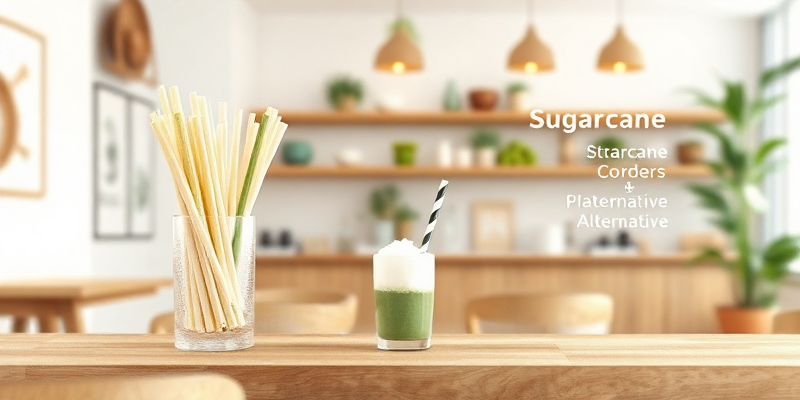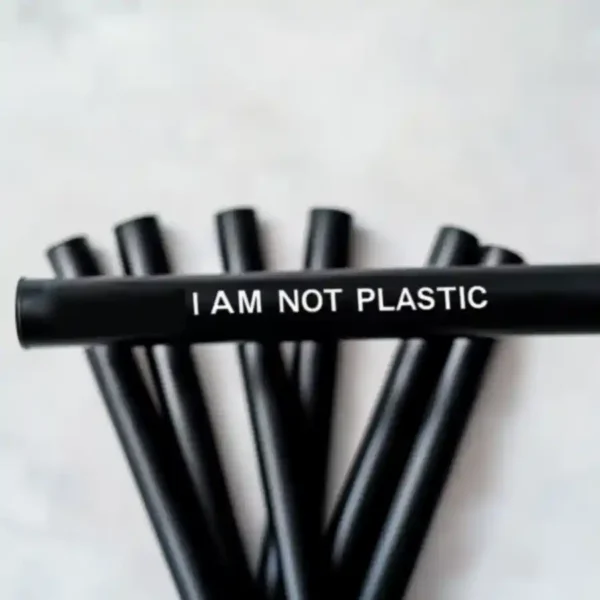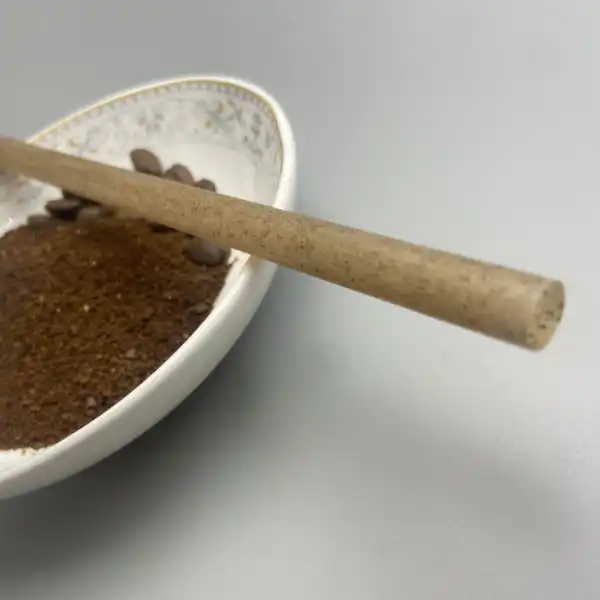持続可能なサトウキビストロー:環境に配慮したビジネス向けのB2Bソリューション

Introduction: Embracing Sustainable Alternatives in a Changing Regulatory Landscape

Picture this: a bustling restaurant chain with locations in California, New York, and Europe facing a logistical nightmare. Half their establishments operate under strict plastic straw bans while others face impending legislation. Their solution? A patchwork approach using different straw types acros locations—creating inventory headaches, inconsistent customer experiences, and spiraling costs.
This scenario isn’t hypothetical—it’s the reality for thousands of businesses navigating the rapidly changing landscape of single-use plastic regulations. Over 130 countries have now implemented some form of plastic restriction, with single-use straws frequently first on the chopping block. For multi-location businesses, keeping up with this regulatory patchwork can be both costly and complex.
持続可能なサトウキビストローに入ります。これは、運用効率を維持しながら、先進的な企業が環境責任にどのようにアプローチするかを変えるゲームを変える代替手段です。廃棄される農業副産物から作られたこれらの革新的なストローは、規制のコンプライアンスと、本物の持続可能な慣行に対する消費者の需要の増加の両方に沿った説得力のあるソリューションを提供します。
持続可能なサトウキビのストローがあなたのビジネス操作に革命をもたらすことができる方法を学ぶ while eliminating the headaches of navigating disparate plastic regulations acros different markets. Unlike conventional plastic straws that persist in our environment for centuries, sugarcane straws fully decompose within 90-180 days in industrial composting facilities—addressing both immediate regulatory concerns and long-term environmental impact.
シフトはもはやオプションではありません。 2023年のマッキンゼーの調査では、消費者の78%が購入決定において持続可能なパッケージングが重要であると考えています。単なる利便性ではなく機能的な必要性としてストローに依存している企業にとって、普遍的で準拠したソリューションを見つけることは、環境管理だけではありません。これは、ますます環境に敏感な市場におけるビジネスの継続性とブランドの評判に関するものです。
Regulatory Compliance: Certifications for Sustainable Sugarcane Straws

環境規制の複雑なWebをナビゲートするACROSさまざまな市場には、善意以上のものが必要です。検証可能なコンプライアンス資格情報が必要です。これは、適切に認定された持続可能なサトウキビストローがグローバルビジネスに大きな利点を提供する場所です。
According to a recent industry compliance report, businesses operating acros multiple jurisdictions spend an average of 287 hours annually managing compliance with various plastic packaging regulations—time that could be redirected toward core busines activities with the adoption of universally compliant alternatives.
NatureBioEco’s sugarcane straws come with the most critical certifications required for international busines operations:
- **FDA Certification**: Essential for any food-contact product in the U.S. market, FDA certification ensures the straws meet strict safety standards for materials that come into direct contact with beverages and food. This certification provides legal protection while assuring customers of product safety.
- **LFGB Certification**: The German Food and Feed Code (LFGB) certification represents one of the world’s strictest standards for food-contact materials, often considered even more rigorous than FDA requirements. This certification opens doors to European markets while demonstrating superior safety commitment.
- **Home Compostability Verification**: Unlike many alternatives that require industrial facilities for proper decomposition, NatureBioEco straws can break down in home composting environments, making disposal genuinely accessible regardles of local waste infrastructure.
Explore the certification advantages of sugarcane straws for your busines あなたがどこで運営されているかを完全に準拠していることを確認してください。この規制上のカバレッジは、ホスピタリティチェーン、食品サービスディストリビューター、および複数の規制環境を操作する飲料メーカーに特別な価値を提供します。
認定されたサトウキビの代替品に切り替える前に、ヨーロッパの3つの市場で45,000ユーロのヨーロッパ市場で45,000ユーロで罰金を科された中サイズのコーヒーチェーンのケースを考えてみましょう。
How Sustainable Sugarcane Straws Compare to Other Eco Alternatives

持続可能なストローオプションを評価するとき、ビジネスメーカーは環境の主張を超えて明確な比較を必要とします。サトウキビのストローが他の人気のある代替品に対してどのように積み重なるかを調べましょう。
| 基準 | サトウキビストロー | プラストロー | 紙ストロー | 竹ストロー |
|---|---|---|---|---|
| ——-- | —————— | ———— | ————– | ————— |
| Durability in Drinks | 2+ hours without softening | 1-2 hours before warping in hot drinks | 30-60 minutes before softening | Excellent, reusable |
| Cost per Unit (Bulk) | $0.03-0.04 | $0.025-0.035 | $0.02-0.03 | $0.15-0.25 |
| 堆肥化可能性 | Home and industrial compostable (90-180 days) | Industrial compost only (requires 140°F) | Compostable but may contain plastic liners | Naturally biodegradable |
| Customer Experience | Natural feel, no taste transfer | Plastic-like feel, some taste transfer | Paper texture, can affect drink taste | Natural feel, slight taste transfer |
| カスタマイズオプション | High – various printing options | Moderate – limited color options | High – full printing capabilities | Limited – primarily etching |
| 二酸化炭素排出量 | Low – uses agricultural waste | 中程度 - トウモロコシ/作物の生産が必要です | 中程度 - 木の収穫が必要です | 低 - 持続可能な収穫 |
によると 国連環境プログラム、プラスチックの代替品の総環境コストは、ライフサイクルの影響全体を考慮すると大きく異なります。驚くべき発見は、サトウキビベースの製品が、生産、輸送、および終末期の処分を考慮したときに、従来のプラスチックと43%LESの代替品と比較して79%のLES CO2排出量を生成することを明らかにしています。
サトウキビのストローが持続可能なビジネスのために他の代替品を上回る理由を発見する when all factors are considered. The practical advantages become particularly evident in real-world busines applications where durability meets sustainability requirements.
While paper straws typically cost les initially, businesses report an average 15-20% higher consumption rate due to customer requests for replacements when straws deteriorate during use—eliminating apparent cost advantages while creating waste and customer dissatisfaction.
Top Busines Benefits of Switching to Sustainable Sugarcane Straws

Beyond environmental considerations, the busines case for sugarcane straws delivers compelling advantages that directly impact your bottom line and brand reputation:
**Enhanced Brand Perception**: A Stanford University study found that products associated with sustainable practices command a price premium of 15-20% among environmentally conscious consumers, who now represent over 60% of the market in many sectors. When customers see your commitment to authentic sustainability through thoughtfully chosen materials, this translates to increased brand loyalty and spending.
**Operational Consistency**: Using a single, globally compliant straw solution acros all locations eliminates the complexity of managing multiple suppliers and inventory types. Businesses implementing unified sustainable materials acros their operations report average administrative cost reductions of 23% related to procurement management.
**Regulatory Future-Proofing**: As plastic regulations continue to expand worldwide, sugarcane straws provide insurance against future compliance costs. Learn how sugarcane straws provide long-term regulatory protection for forward-thinking businesses looking to avoid adaptation costs as legislation evolves.
**Marketing Differentiation**: Tangible sustainability initiatives give businesses concrete stories to share with increasingly eco-conscious consumers. These narratives perform 37% better in social media engagement compared to generic promotional content, creating organic brand ambassadors through customer sharing.
**Tax Incentives and Compliance Cost Avoidance**: Many jurisdictions now offer tax benefits for businesses adopting certified sustainable materials, while simultaneously imposing fees or penalties on traditional plastics. One mid-sized restaurant chain reported annual savings of $42,000 acros 30 locations after factoring in plastic taxes avoided and sustainability incentives gained.
The ROI extends beyond direct financial metrics—when staff can confidently explain your sustainable practices to inquiring customers, it creates positive touchpoints that differentiate your busines from competitors still using conventional plastics or les effective alternatives.
Environmental Impact: Why Sustainable Sugarcane Straws Wins

The environmental advantages of sugarcane straws extend far beyond simple biodegradability—they represent a circular economy approach that transforms what would otherwise be agricultural waste into valuable products.
Sugarcane bagasse—the fibrous byproduct remaining after sugar extraction—would typically be burned or discarded, releasing carbon back into the atmosphere. By repurposing this material into functional products, sugarcane straws actually sequester carbon while reducing dependence on virgin resources.
A lifecycle assessment conducted by the Environmental Research Institute found that for every 1 million sugarcane straws produced, approximately 2.7 metric tons of CO2 equivalent emissions are avoided compared to traditional plastic straws. サトウキビのコーヒーストローに切り替えることの完全な環境上の利点を探る あなたの飲み物サービスのために。
おそらく最も重要なことは、終末期シナリオは、代替案とはまったく対照的です。
- サトウキビのストローは、商用堆肥化施設で90〜180日以内に完全に分解します
- 彼らは家の堆肥化環境で180〜240日で壊れます
- 埋め立て地であっても、従来のプラスチックやPLAの代替品よりも大幅に速く劣化します
- 分解中にマイクロプラスチックや有毒な残基を残しません
単なるグリーンウォッシングではなく本物の持続可能性に専念する企業にとって、この完全なライフサイクルの考慮は、サトウキビが現在利用可能な最も環境に責任のある選択肢の1つを表しているという説得力のある証拠を提供します。
Case Study: Sustainable Sugarcane Straws Succes in Action

3つの沿岸州を運営する28のビーチサイドコーヒーショップの地域チェーンであるCoastalcaféは、厳格な地元のプラスチックの禁止、環境に配慮した顧客、海洋保存を中心に構築されたブランドアイデンティティなど、挑戦の完璧な嵐に直面しました。彼らの最初のソリューション - 紙のストローへのスイッチング - は、主要な製品カテゴリであるアイス飲料の急速な劣化により、即時の顧客の反発を作成しました。
NatureBioeco Sugarcane Straws Acrosすべての場所を実装した後、結果は驚くべきものでした。
- **Customer Satisfaction**: Complaints about straw performance decreased by 93% within the first month
- **Cost Efficiency**: Despite a 7% higher unit cost than paper alternatives, overall straw expenses decreased by 12% due to reduced waste and fewer replacement requests
- **Brand Alignment**: Social media mentions of their sustainable practices increased 215%, with 78% of those mentions specifically highlighting the superior straw experience
- **Staff Efficiency**: Employees saved an estimated 45 minutes per day previously spent addressing straw-related complaints and providing replacements
“The sugarcane straws perfectly align with our coastal preservation message while actually delivering a better customer experience than even our original plastic straws,” noted Maria Chen, CoastalCafé’s Director of Operations. “What started as a compliance necessity has become a brand differentiator.”
See how other businesses have successfully implemented sustainable coffee straws in their operations with similar benefits to customer satisfaction and operational efficiency.
最も顕著なメトリック? Coastalcaféの年次顧客調査では、ブランドの環境へのコミットメントに対する認識が22%増加し、環境に配慮した人口統計の中で繰り返しの顧客頻度が17%増加することと直接相関しています。
よくある質問
- サトウキビのストローが他の持続可能な代替品と違うのはなぜですか?
- 産業用堆肥化を必要とする紙ストローとは異なり、サトウキビのストローは、堆肥化可能なままでいる間、例外的な耐久性(柔らかくすることなく液体で2時間以上)を提供します。それらは、廃棄される農業副産物(バガス)から作られており、環境への影響を最小限に抑えた循環経済ソリューションを作成します。
- サトウキビストローは、FDAが食品接触のために認定されていますか?
- Yes, NatureBioEco’s sugarcane straws meet rigorous FDA certification standards for food-contact materials, ensuring they’re safe for direct contact with beverages and comply with health regulations. They also meet LFGB standards, considered among the strictest food-contact certifications globally.
- What is the minimum order quantity for B2B customers?
- NatureBioEco offers flexible minimum order quantities starting at 10,000 units for standard products, with customization options available at slightly higher minimums. Volume-based pricing tiers provide significant cost advantages for larger orders, making them ideal for businesses of various sizes.
- Can sugarcane straws be customized with our branding?
- 絶対に! NatureBioecoは、ロゴ印刷、色のバリエーション、カスタムパッケージングオプションなどの包括的なカスタマイズを提供しています。カスタムブランドのサトウキビストローは、毎日の顧客とのやり取りを通じてブランドのアイデンティティを強化しながら、強力な持続可能性メッセージを作成します。
- サトウキビのストローは分解するのにどれくらい時間がかかりますか?
- サトウキビのわらは、市販の堆肥化施設で90〜180日以内、家の堆肥化環境で180〜240日以内に分解します。埋め立て地であっても、それらはプラスチックの代替品よりも大幅に速く分解します。
- サトウキビのストローはプラスチックストローよりも高価ですか?
- ユニットコストは通常、従来のプラスチックストローよりも20〜30%高くなっていますが、多くの企業は、規制コンプライアンスの節約、プラスチック税の回避、マーケティングの利点によって総コストの差が相殺されることを発見しています。ボリューム価格設定は、大規模な注文のコスト差を大幅に削減できます。
- サトウキビのストローは、最大の貯蔵寿命のためにどのように保管すべきですか?
- サトウキビのストローは、直射日光から離れた乾燥状態で保管すると、2年以上の優れた貯蔵寿命があります。それらの自然な安定性により、他の持続可能な代替品と比較して、特別な取り扱い要件を最小限に抑えるBusines在庫管理に最適です。







